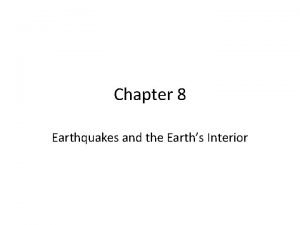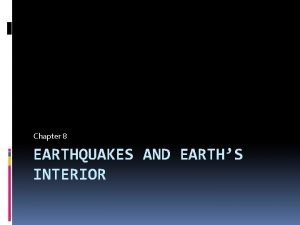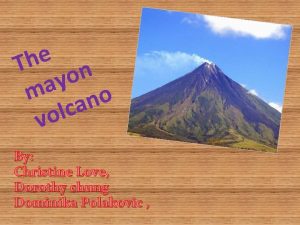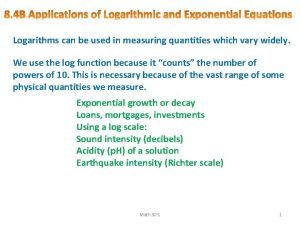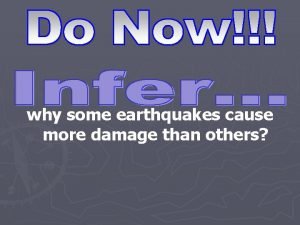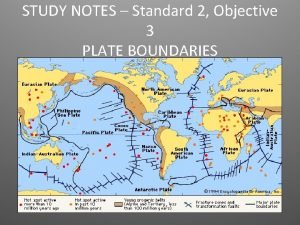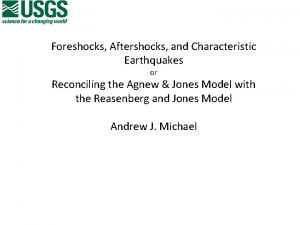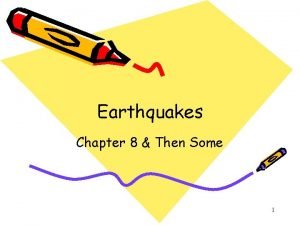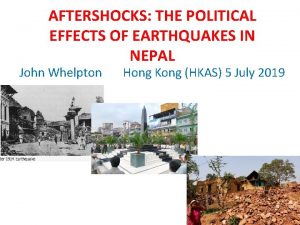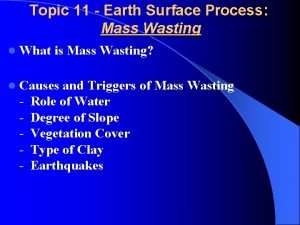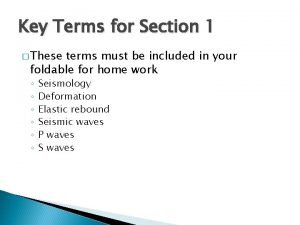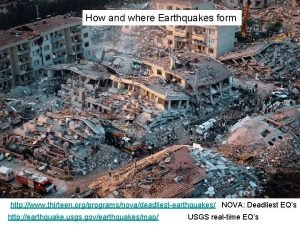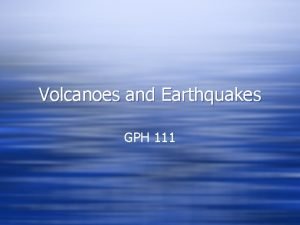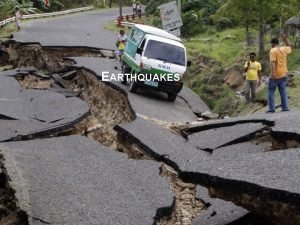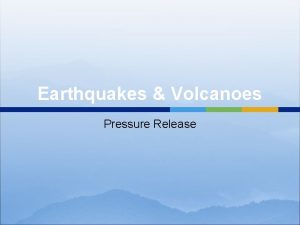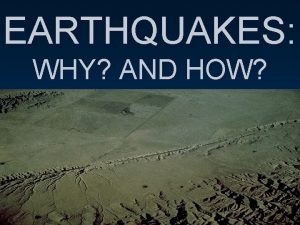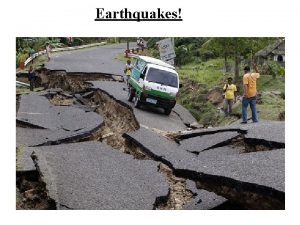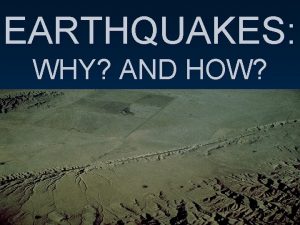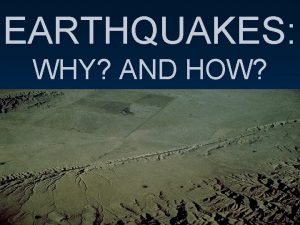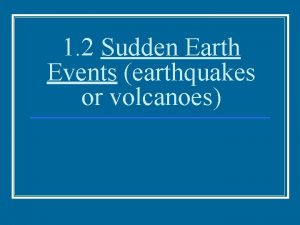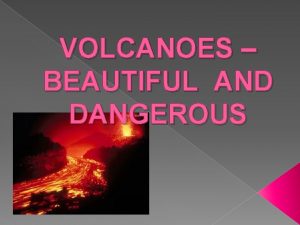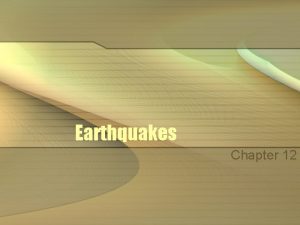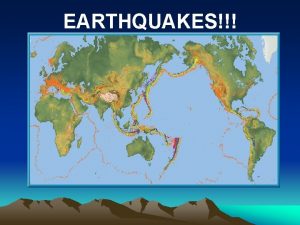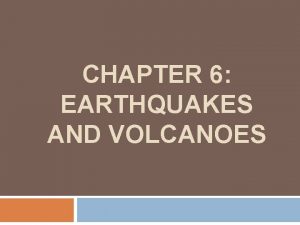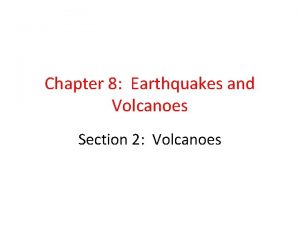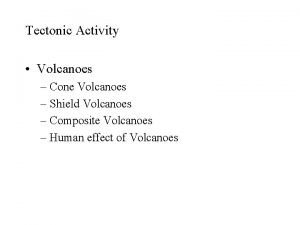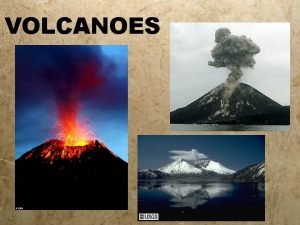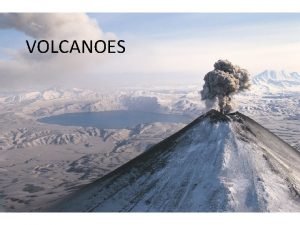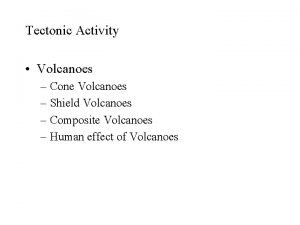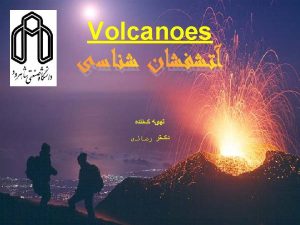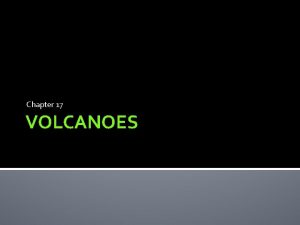VOLCANOES AND EARTHQUAKES CHARACTERISTICS SUDDEN PROCESSES ACT SLOWLY






















- Slides: 22

VOLCANOES AND EARTHQUAKES

CHARACTERISTICS • • SUDDEN PROCESSES ACT SLOWLY VERY SUDDEN EFFECTS VOLCANOES AND EARTHQUAKES

VOLCANOES • Sudden and abrupt explosion of the crust • Magma, dust, smoke and solid materials ejected – Great pressure through a pipe known as vent – Cone-like feature- volcanic cone – Funnel shaped depression top of the cone- crater – Sometimes secondary cones may also be formed

Causes of volcanic eruptions • High temperature in the interior of the earth – Melting of rocks at great depths. • Weaker sections of the earth’s crust • Gases- water vapour most effective – Percolated rain water is heated inside – Sea water along the coast also heated – Increases heat and pressure within water vapour • Earthquakes- release of pressure at fault zones • Plate Tectonics- subduction

Materials ejected by volcanoes • Gases- mainly steam- 60 to 90% of all gases – Causes heavy rainfall following condensation • Liquids- lava- temperature-600°C to 1200°C – Speed varies- 15 km to 80 km per hour • Solids- lava solidifies within the lava tubes – At next eruption, solidified lava ejected out with force

Types of volcaanoes • Active- material ejected at frequent intervals – Etna- 2500 years – Stromboli- explodes every 15 minutes • Dormant- eruption does not occur regularly – Cause great damage to life and property – Vesuvius-erupted only 10 times in last 1500 years – Barren Island- India- erupted in 1991 • Extinct- Vent is blocked or moves away from hot spot – Rarely becomes active- Krakatoa 1883

Volcanic Landforms • Ash or Cinder cone- Circular, cooling of granitic lava around the crater – average height- 300 m – Concave sloped sides • Basic lava cone (Shield)- Flatter, cooling of basic lava - wide base, low slope, cools as sheets • Composite cone- Largest and highest of all types – Lava deposited parallely on top of each other • Caldera- large roughly circular depression • Crater Lake- Funnel shaped crater filled with rain

Influence of volcanoes on man ADVANTAGES • Release of intense pressure- safety valve • Helps in studying interior of the earth • Fertile black soils • Many valuable minerals • Geysers, mineral springs and crater lakes • Geo thermal energy • Crater lakes- used for irrigation

Influence of volcanoes on man DISADVANTAGES • Highly destructive to life and property • Cause earthquakes • Lava flow destroys agricultural lands • Undersea eruptions destroy marine life • Poisonous gases are released- pollution to air • Sudden changes in world maps- Krakatoa Island

Distribution of volcanoes • Mostly found at sea coasts, percolation of water • At new fold mountains- thinner crust • Boundaries of plates – Bordering Pacific Ocean- 403 active volcanoes – Mid-world belt- Alpine-Himalaya belt. – African rift valley– Mid Atlantic ridge- Iceland – Madagascar island – Hawaiian Islands

EARTHQUAKES • Tremors caused by passage of seismic waves • Any sudden disturbance causes vibrations that travel in all directions. • 8000 to 10000 earthquakes occur all over the world, 1 per hour • More common in the oceans. • Originate at depths of 50 to 100 km below earth’s surface • Place of origin- hypocentre/focus. • Point vertically above focus- epicentre, earthquake strongest here

Causes of earthquakes • Volcanic eruptions- most earthquakes occur in volcanic regions • Contraction of the earth- contraction creates disorder in rocks • Folding and faulting- compression and tension in rocks. Bihar earthquake in 1934, Assam in 1950, Uttar Kashi in 1991 • Plate Tectonics- subduction of oceanic plates • Artificial- running trains, heavy machines, bomb explosions.

Effects of earthquakes • • • Heavy loss to life and property Disturb rock strata- change course of rivers Tsunamis Disrupts roads, creates huge faults Causes landslides Helps in studying the interior of the earth Weathering due to landslides helps in soil formation New landforms are created Creation of bays- natural harbours, help in trade Valuable minerals brought up to the surface

Distribution of earthquakes • Similar to presence of volcanoes – Circum-Pacific belt- 68% of world’s earthquakes occur here – Mid-world mountain belt- 21% of world’s earthquakes, parallel to equator, fold mountains, large depressions and active volcanoes – Minor belts- African Lakes, Red Sea and Dead Sea zones

Earthquakes in India • Mostly confined to Himalayan region, Ganga valley – Kutch- 1819 – Assam- 1877 – Kangra- 1905 – Bihar- 1934 – Assam- 1950 – Himachal- 1975 – Uttarkashi- 1991 – Kutch- 2001

Protection from earthquakes • Cannot prevent, but safety can be assured – Large number of scientific centres to be set up – Warning system must be strong – Building structures should be changed – Prevent changes in environmental conditions

Effects of earthquakes- Tsunamis • Sea quakes- violent movement in sea water • Japanese word ‘tsu’ meaning harbour, ’nami’ meaning wave • Series of waves, generate near or below ocean floor, can travel across oceans

Formation of Tsunamis • Caused by any endogenous process • Most destructive due to undersea earthquakes • Strong earthquake 7. 5 on the richter scale, tilts or deforms oceanic crust, sea water above is displaced, waves are formed as water tries to retain its position, this vertical movement generates tsunami waves • Subduction zones, displacement of heavier crust under lighter crust, creation of fault, tsunami occurs

Propogation of Tsunamis • Only caused due to vertical propogation of waves in all directions • Movement resembles ripples in a pond of water • Travels at high speeds( 500 -800 km/hr) in deep seas, long wave-lengths • Cant be seen or detected from the air. • As they approach shores, speed is reuced and they attain enormous height>10 m to 30 m

Effects of Tsunamis • Flood hundreds of metres of inland, flatten houses, wipe out villages, uproot electric poles, throw cars around, toss boats ashore & drag helpless people back into the sea. • Large rocks and debris may be transported inland, it can travel up rivers and streams and cause damage to crops. • Tsunamis generated on one side of an ocean may have its effects felt of the opposite side

Measuring earthquakes • Measured in terms of intensity and magnitude • Intensity means destructive power- severity of ground motion, measured in relation to effects on human life, directly observed by people • Mercalli scale- 1 to 12 intensities • Intensity depends on– Total amount of energy released – Distance of place from epicentre – Types of rocks prrsent

Measuring earthquakes • Magnitude- energy releases at the epicentre, estimates severity of an earthquake. • Exponential scale- 2 to 9 • Each increase in a whole number is 10 times greater than the previous one
 Chapter 8 earthquakes and volcanoes
Chapter 8 earthquakes and volcanoes Concurrent processes are processes that
Concurrent processes are processes that Chapter 8 section 1 what are earthquakes
Chapter 8 section 1 what are earthquakes Chapter 8 earthquakes and earth's interior
Chapter 8 earthquakes and earth's interior Chapter 8 earthquakes and earth's interior answer key
Chapter 8 earthquakes and earth's interior answer key Interesting facts about mt mayon
Interesting facts about mt mayon What are destructive forces
What are destructive forces Act 1 act 2 act 3
Act 1 act 2 act 3 In what section of earth do earthquakes happen?
In what section of earth do earthquakes happen? Btn earthquakes
Btn earthquakes Hazard picture
Hazard picture Http://earthquake.usgs.gov/earthquakes/map/
Http://earthquake.usgs.gov/earthquakes/map/ A large crack in the earth formed by a river or earthquakes
A large crack in the earth formed by a river or earthquakes Chapter 19 earthquakes
Chapter 19 earthquakes Why do some earthquakes cause more damage than others
Why do some earthquakes cause more damage than others Frequent earthquakes in an area may indicate
Frequent earthquakes in an area may indicate Earthquakes
Earthquakes Quiz 1: earthquakes
Quiz 1: earthquakes Earthquakes
Earthquakes Landslides caused by earthquakes
Landslides caused by earthquakes Elastic rebound theory
Elastic rebound theory Why do earthquakes occur
Why do earthquakes occur What are the factors of earthquake
What are the factors of earthquake



